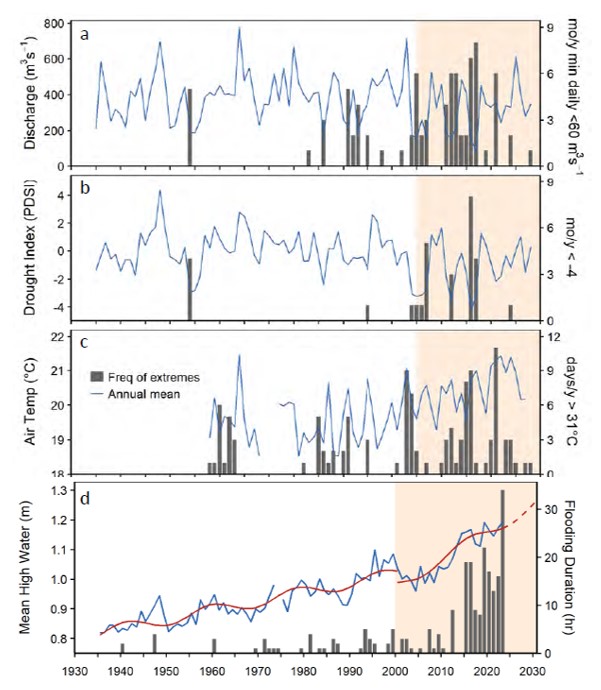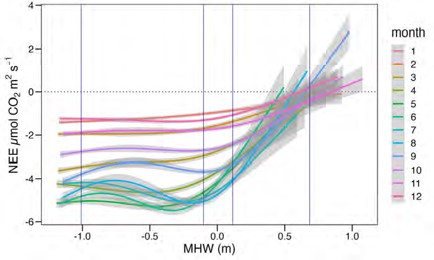Area 1: External Drivers of Change
|
|||||
|---|---|---|---|---|---|
External Drivers of ChangeOur goal for this area is to characterize external drivers such as climate change, sea-level rise, and human alterations of the landscape in terms of long-term trends, spatio-temporal variability, and occurrence of extreme events (e.g., storms, droughts) so that we can investigate the links between external drivers and ecosystem response. This includes collecting ongoing information on climate and oceanographic conditions, sea level, and river discharge (Fig 1). Research ObjectivesA) Environmental Drivers
B) Human Drivers
|
|||||
Current Progress ReportBelow is an update for each of the Area 1 objectives as reported in the most recent annual report. For a list of all reports click here (Annual Reports). A) Environmental Drivers

Fig1. Locations of observing stations used for boundary conditions (ML is Marsh Landing; UGAMI is UGA Marine Institute). 
Fig. 2. Fig. 1. Left axes: Long-term patterns in mean annual (a) river discharge (USGS gage at Doctortown), (b) Palmer Drought Severity Index (NOAA), (c) air temperature (NWS UGAMI station),and (d) annual mean high water levels (Fort Pulaski, GA). Right axes: frequency of (a) months in a given year when minimum daily discharge < 60 m3s-1, (b) months in a year of extreme drought (PDSI < -4), (c) days in a year with mean temperature > 31oC, (d) number of hours tide levels exceeded the NOAA high-tide flooding threshold (> 0.59 m above MHHW) Period of the GCE project shaded in peach, with dashed lines showing projections through GCE-V.

Fig. 3. Daytime 30-min NEE grouped by month relative to mean high water (MHW) at the GCE flux tower (2014-2023) show the lowest NEE during the growing season (April through August) and a non-linear increase as the marsh surface becomes inundated during tidal flooding.
B) Human Drivers
|
|||||
Area 1 Publications from GCE-IVRobinson, M., Alexander, C.R. Jr. and Venherm, C. 2022. Shallow Water Estuarine Mapping in High-Tide-Range Environments: A Case Study from Georgia, USA. Special Issue: Shallow Water Mapping. Estuaries and Coasts. 45:980-999. (DOI: https://doi.org/10.1007/s12237-021-01032-y) Ritchison, B.T., Thompson, V.D., Lulewicz, I.H., Tucker, B. and Turck, J.A. 2021. Climate Change, Resilience, and the Fisher-Hunter-Gatherers of Late Holocene Georgia Coast. Quaternary International. (DOI: 10.1016/j.quaint.2020.08.030) Heynen, N. 2020. A plantation can be a commons: Re-Earthing Sapelo Island through Abolition Ecology. Antipode. 0(0):20. (DOI: 10.1111/anti.12631) Napora, K., Cherkinsky, A., Speakman, R.J., Thompson, V.D., Horan, R. and Jacobs, C. 2019. Radiocarbon Pretreatment Comparisons of Bald Cypress (Taxodium distichum) Wood Samples from a Massive Buried Deposit on the Georgia Coast, USA. Radiocarbon. 61:1755-1763. Turck, J.A. and Thompson, V.D. 2019. Human-Environmental Dynamics of the Georgia Coast. In: Reeder-Myers, L., Turck, J. and Rick, T. (editors). The Archaeology of Human-Environmental Dynamics on the North American Atlantic Coast. University Press of Florida, Gainesville, GL. Bailey, M. and Heynen, N. 2020. Sweet (and sticky) redemption. In: Scalawag Magazine. Area 1 Publications from GCE-IIIJournal ArticlesNahrawi, H.B., Leclerc, M.Y., Pennings, S.C., Zhang, G., Singh, N. and Pahari, R. 2020. Impact of tidal inundation on the net ecosystem exchange in daytime conditions in a salt marsh. Agricultural and Forest Meteorology. 294:108133. (DOI: https://doi.org/10.1016/j.agrformet.2020.108133) Sheldon, J.E. and Alber, M. 2002. A comparison of residence time calculations using simple compartment models of the Altamaha River estuary, Georgia. Estuaries. 25(6B):1304-1317. Conference Papers (Peer Reviewed)Conference Posters and PresentationsDugan, J., Alber, M., Alexander, C.R. Jr., Byers, J., Emery, K., Gehman, A., Lawson, S. and McLenaghan, N.A. 2015. Poster: A conceptual model for predicting the ecological effects of coastal armoring in soft-sediment environments. Coastal and Estuarine Research Federation Biennial Meeting, August 30 - September 2, 2015, Estes Park, CO. Dugan, J., Alber, M., Alexander, C.R. Jr., Byers, J., Emery, K., Gehman, A., Lawson, S. and McLenaghan, N.A. 2015. Poster: A conceptual model for predicting the ecological effects of coastal armoring in soft-sediment environments. Coastal and Estuarine Research Federation Biennial Meeting, November 8-12, 2015, Portland, OR. Gehman, A., McLenaghan, N.A., Byers, J., Alexander, C.R. Jr., Pennings, S.C. and Alber, M. 2015. Poster: Effects of development and shoreline armoring on the high marsh ecosystem. Benthic Society Ecology Meeting 2015, March 4-7, 2015, Quebec City, CN. Sheldon, J.E. and Burd, A.B. 2009. Presentation: An In-depth Look at Alternating Effects of Climate Signals on Freshwater Delivery to Coastal Georgia, U.S.A. Hydrologic Prediction in Estuaries and Coastal Ecosystems. CERF 2009: Estuaries and Coasts in a Changing World, November 1-5, 2009, Portland, OR. Alber, M. and Sheldon, J.E. 2006. Calculating estuary turnover times during non-steady-state conditions using freshwater fraction techniques. Southeastern Estuarine Research Society meeting, Ponte Vedra Beach, Florida. Alber, M. and Sheldon, J.E. 2006. Presentation: Simple tools for assessing coastal systems: can we get there from here? Coastal Observing Systems Workshop, LTER All Scientists Meeting, September 20-24, 2006, Estes Park Colorado. Sheldon, J.E. and Alber, M. 2005. Presentation: Beyond whole-estuary flushing times: Using transport times through salinity zones to explain chlorophyll patterns in the Altamaha River estuary (Georgia, USA). Estuarine Interactions: biological-physical feedbacks and adaptations. 2005 Estuarine Research Federation Meeting. October 16-20, 2005, Norfolk, Virginia. Sheldon, J.E. and Alber, M. 2004. Presentation: SqueezeBox: Flow-scaled 1-D box models for estuary residence time estimates. NOS Workshop on Residence/Flushing Times in Bays and Estuaries. National Oceanic and Atmospheric Administration, June 8-9, 2004, Silver Spring, Maryland. Sheldon, J.E. and Alber, M. 2004. Presentation: SqueezeBox: Flow-scaled 1-D box models for estuary residence time estimates. Spring 2004 meeting. Southeastern Estuarine Research Society (SEERS), October 14-16, 2004, Wilmington, North Carolina. Sheldon, J.E. and Alber, M. 2003. Presentation: The equivalence of estuarine turnover times calculated using fraction of freshwater and tidal prism models. 2003 Estuarine Research Federation meeting, Sept. 14-18, 2003, Seattle, WA. Alber, M. and Sheldon, J.E. 2000. Presentation: Residence times in the Altamaha River Estuary: a progress report. Southeastern Estuarine Research Society Meeting. Southeastern Estuarine Research Society, Oct 01, 2000, Tampa, Florida. Newsletter and Newspaper Articles |
|||||



